TL;DR
Want to avoid interior design mistakes that decrease home value? Focus on five pillars: clear furniture flow, layered lighting, fresh and ventilated bathrooms, curated personality, and ruthless decluttering. Start with high-impact, low-cost fixes like pathway clearances of 36 inches, 2700K–3000K bulbs on dimmers, and re-caulking wet zones.
Why the way you decorate can change what buyers will pay
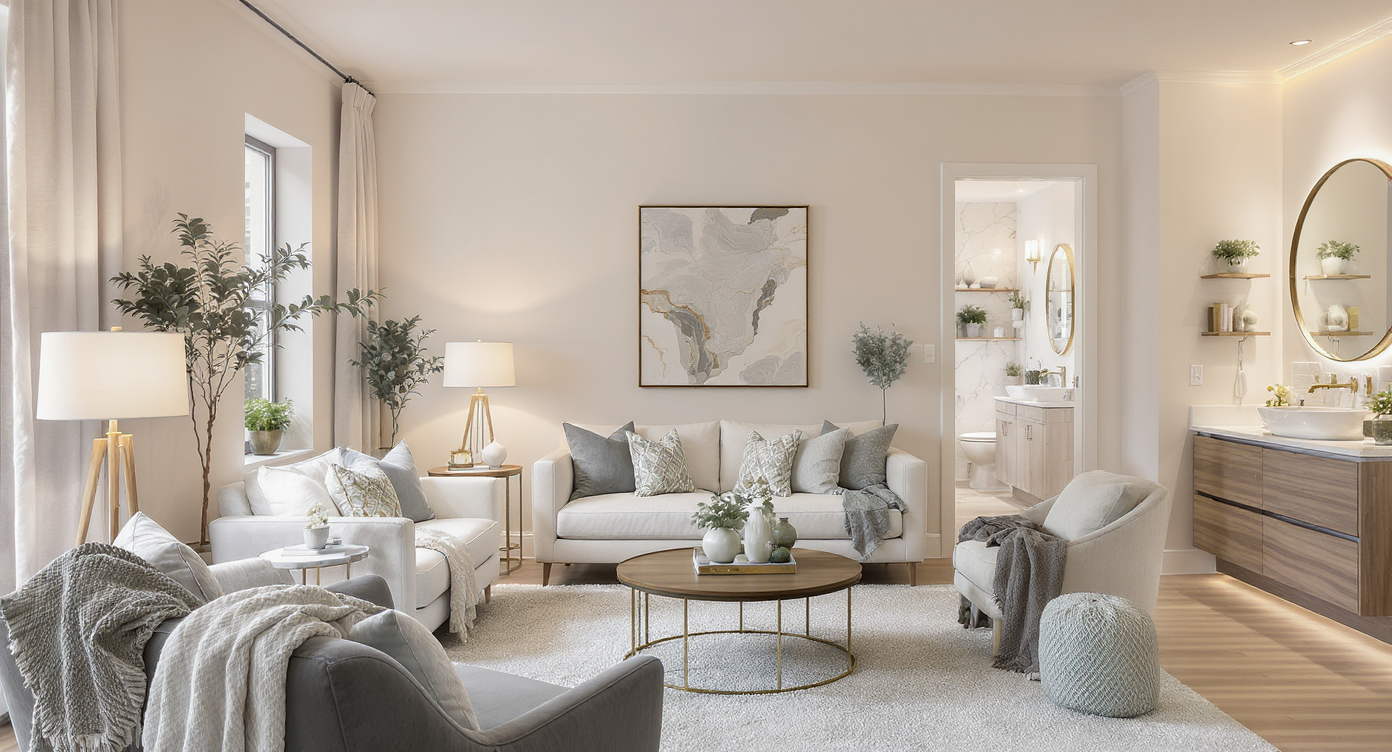
Key design elements like flow, lighting, and personality elevate spaces and protect home value in resale.
Here’s the thing: interior design isn’t just about taste — it’s a financial lever. The right choices raise perceived quality and reduce buyer objections; the wrong ones do the opposite. If you’re worried about interior design mistakes that decrease home value, you’re not alone. Buyers mentally tally light, layout, freshness, and storage the second they walk in.
In resale-focused design, five themes dominate: furniture placement and flow, layered lighting, clean and updated bathrooms, a sense of personality (not generic staging), and clutter control. When those are dialed in, even modest homes show up like premium listings. When they’re off, price reductions follow. The good news? Most fixes are weekend projects with measurable payoff.
The fix-first plan: how to improve home value with interior design
Start with circulation, lighting levels, and moisture management; these drive first impressions and inspection outcomes, which influence resale value more than decor trends. Experts recommend solving functional issues before cosmetic styling.
- Flow and furniture placement: Aim for 36-inch clear walkways and seat groups that face the focal point (fireplace, TV wall, or view). Pull sofas 6–12 inches off the wall to create breathing room and anchor with a rug that lets at least the front legs of seating sit on it.
- Layered lighting: Use a trio: ambient, task, and accent. Target roughly 10–20 lumens per square foot in living rooms and 30–40 in kitchens. Choose warm-white 2700K–3000K bulbs with a CRI of 90+ and put primary fixtures on dimmers for instant mood control.
- Bathrooms that feel fresh: Replace tired caulk and grout, swap pitted faucets for simple brushed nickel or matte black, and install a vent fan rated at 1 CFM per square foot (round up) ducted outdoors. Good ventilation prevents mildew — a value killer.
- Curated personality: Keep your story, edit the noise. Follow an 80/20 rule: 80 percent timeless foundation (neutrals, classic lines), 20 percent personal pieces (art, textiles, books) to avoid model-home blandness.
- Declutter and stage: Remove roughly one-third of accessories and duplicate furniture. Clear counters except 1–3 attractive, functional items per surface. Storage sells the idea of space; show it off by half-filling key closets and pantries.
User insight: Most homeowners underestimate how much lighting affects perceived square footage. In walk-throughs, buyers consistently describe well-lit rooms as “bigger” even when dimensions are unchanged.
Anecdote
Suggested image alt text and captions for accessibility and SEO:
- Alt: Bright living room with layered lighting, large rug, and sofa facing fireplace. Caption: Clear focal point and layered light increase perceived space.
- Alt: Small bathroom with fresh caulk, updated faucet, and vent fan. Caption: Simple bath fixes signal care and reduce buyer objections.
Common interior design mistakes that decrease home value
Five avoidable missteps repeatedly lower offers; tackling them early protects resale value and livability.
- Blocking the focal point: Sofas facing away from the fireplace or TV confuse the room’s purpose. Turn seating to the main feature and keep 8–10 feet between opposing seats for comfortable conversation.
- Relying on a single overhead light: One fixture creates shadows and a flat, dull effect. Add two to three supplementary sources — a floor lamp near seating, under-cabinet strips in kitchens, a sconce or picture light for art.
- Dated, dingy bathrooms: Yellowed caulk, corroded fixtures, and poor ventilation read as deferred maintenance. Refresh with new silicone, a $150–$300 faucet set, LED vanity lighting at eye level, and a properly sized exhaust fan.
- Personality vacuum: Over-staging to “hotel bland” can backfire. Buyers connect when they see a few authentic cues — a small gallery of travel photos, a vintage chair, a favorite textile — not walls of generic signs.
- Visual clutter and overcrowding: Too many small items makes rooms feel smaller. Edit accessories by scale and group in odd numbers; store the rest. Negative space is part of the design.
Expert tips that nudge resale value upward
Small, measurable choices compound into a premium look; designers often advise simple standards to remove guesswork.
- Rug math that works: In living rooms, choose a rug that extends 18–24 inches beyond the coffee table on all sides. For bedrooms, 8×10 under a queen or 9×12 under a king keeps toes off cold floors.
- Art height, instantly better: Hang art so the center sits around 57 inches from the floor — close to gallery eye level.
- Window treatments that lift: Mount rods 4–6 inches above the frame and extend 6–10 inches wider than the window to make openings feel larger.
- Color that sells: A restrained palette of three hues (one dominant, one secondary, one accent) reads cohesive. Warm neutrals with a single saturated accent photograph beautifully for listings.
- Kitchen glow-up on a budget: Swap hardware to a simple bar pull, add 3000K under-cabinet LEDs, and style two vignettes (cutting board + bowl; plant + cookbook). It’s a half-day project with outsized impact.
Reflection: The homes that fetch multiple offers don’t look expensive; they look intentional. Intention is the quiet luxury buyers feel before they know why.
Real-home stories: quick changes, real equity
Short, lived-in examples help illustrate how small tweaks turn into measurable value and daily comfort.
- The flipped sofa: A couple kept their sectional jammed against a wall facing away from the fireplace. We floated it, centered on a larger rug, and added a floor lamp. The living room suddenly felt twice as connected; their agent later credited the layout change for stronger open-house traffic.
- The $500 bath refresh: One homeowner replaced a tired vanity light, re-caulked the tub, installed a 110 CFM fan for a tiny 8×10 bath, and swapped faucets. The room went from “needs work” to “clean and cared for,” trimming buyer repair lists to near zero.
- From bland to memorable: A townhouse staged in gray everything sat for weeks. Adding a vintage runner, a trio of framed travel photos, and a warm terracotta throw gave it a point of view. Offers followed after the new photos hit the listing.
- The lighting leap: A dark dining area lit by a single flush-mount got a dimmable pendant plus two plug-in sconces. Dinner felt like an occasion, and the space photographed like a magazine spread.
Visualization Scenario
Imagine stepping into your living room at dusk. Warm 3000K lamps glow, the sofa frames the fireplace, a textured rug connects the seating, and side tables hold just what you need. The air feels fresh, counters are calm, and a few personal pieces tell your story. Now imagine a buyer walking in — they feel it, too.
FAQ: quick answers for search-worthy questions
What interior design mistakes decrease home value the most?
The biggest culprits are poor furniture placement and flow, single-source lighting, dated or dingy bathrooms, generic staging with no personality, and clutter. Fixing these high-impact issues improves perceived quality and resale value.
How should I place furniture for better flow and resale value?
Maintain 30–36 inches of clear walkways and aim seating toward a focal point such as a fireplace or TV wall. Keep 8–10 feet between sofas and chairs for conversation and anchor with a properly sized area rug.
What’s the best lighting for a living room to boost resale value?
Layer ambient, task, and accent lighting using 2700K–3000K bulbs and dimmers, targeting 10–20 lumens per square foot. Multiple light sources make rooms feel larger and more inviting.
Which bathroom upgrades add value on a budget?
Re-caulk and re-grout, replace dated faucets and vanity lighting, and install a code-appropriate exhaust fan at 1 CFM per square foot. These changes make a bathroom feel clean, bright, and well maintained.
How do you declutter and stage a home without it feeling empty?
Remove roughly one-third of accessories and duplicate furniture, then group remaining items by scale in odd numbers. Keep counters minimal with 1–3 functional, attractive pieces per surface to signal space and order.
What to do this weekend
Walk your home like a buyer: measure pathways for 36-inch clearances, re-aim seating to the focal point, replace a few bulbs with 2700K–3000K dimmables, and tackle one bath’s caulk and fan. Then edit accessories until you’ve removed a third. These moves cost little and start paying you back in comfort right now, and in resale value later.
Need a visual to get started? Use ReimagineHome to test furniture placement, lighting mood, and color schemes on photos of your actual rooms — and save the versions that feel most like you.
.svg)

.svg)


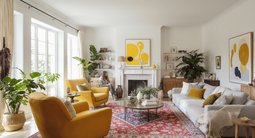


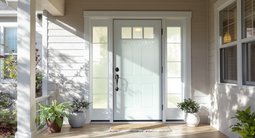

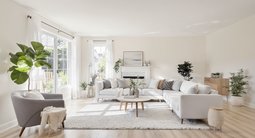

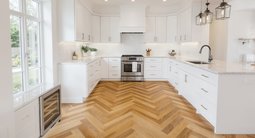

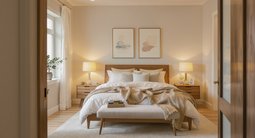


.png)